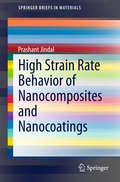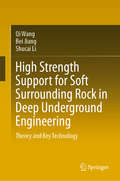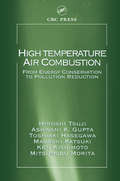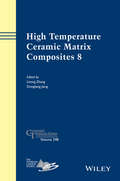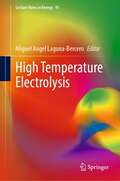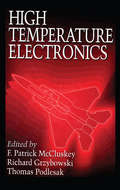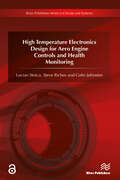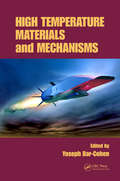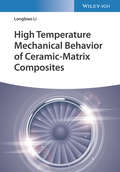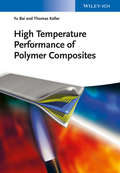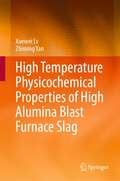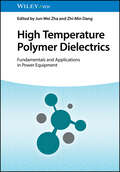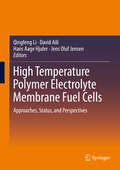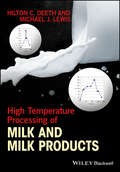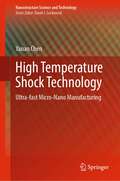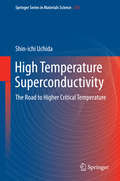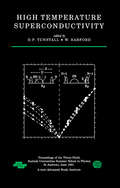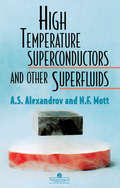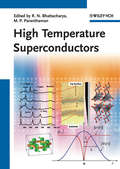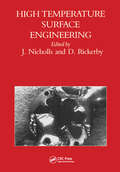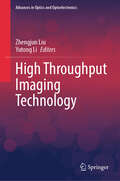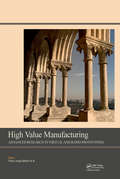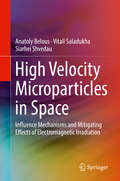- Table View
- List View
High Strain Rate Behavior of Nanocomposites and Nanocoatings
by Prashant JindalThis book describes the use of multiwall carbon nanotubes as composites with polycarbonates and as protective coatings on glass surfaces. The book explains fabrication and characterization methods for these composites and coatings. The author reports on the use of Split Hopkinson Pressure Bar set up for evaluating the dynamic strength of these composites and coatings and studying the role of carbon nanotubes in the enhancement of their dynamic strength.
High Strength Support for Soft Surrounding Rock in Deep Underground Engineering: Theory and Key Technology
by Qi Wang Bei Jiang Shucai LiThis book examines the field of surrounding rock control mechanisms and support technologies in underground engineering, and proposes a high-strength support system to address the complex conditions in underground engineering, such as high stress, extremely soft rocks, fault fracture zone and strong mining activity. It also comprehensively discusses the concept and bearing mechanisms of the supporting system, design calculation methods, field application and key construction technologies. The book describes the design and construction of a large-scale mechanical test system, independently developed by the author for high- strength confined concrete arches, which can also be used to define the mechanism of deformation and failure of confined concrete arches. Further, the book explores the application of the confined concrete support system in underground engineering with complex conditions, and its control effect on soft surrounding rock.The first international book presenting the theory and key technologies of high-strength, confined concrete support, it is a valuable reference resource for design, construction and supervision staff in the field of geotechnical engineering, as well as for teachers, students and researchers.
High Tech Heretic: Why Computers Don't Belong in the Classroom and Other Reflections by a Computer Contrarian
by Clifford StollInteresting analysis of the use and misuse of technology in education.
High Temperature Air Combustion: From Energy Conservation to Pollution Reduction
by Hiroshi Tsuji Ashwani K. Gupta Toshiaki Hasegawa Masashi Katsuki Ken Kishimoto Mitsunobu MoritaMaximize efficiency and minimize pollution: the breakthrough technology of high temperature air combustion (HiTAC) holds the potential to overcome the limitations of conventional combustion and allow engineers to finally meet this long-standing imperative. Research has shown that HiTAC technology can provide simultaneous reduction of CO2 and nitric
High Temperature Ceramic Matrix Composites 8
by Litong Zhang Dongliang JiangThis proceedings contains 78 papers from the 8th International Conference on High Temperature Ceramic Matrix Composites, held September 22-26, 2013 in Xi'an, Shaanxi, China. Chapters include: Ceramic Genome, Computational Modeling, and Design Advanced Ceramic Fibers, Interfaces, and Interphases Nanocomposite Materials and Systems Polymer Derived Ceramics and Composites Fiber Reinforced Ceramic MatrixComposites Carbon-Carbon Composites: Materials, Systems, and Applications Ultra High Temperature Ceramics and MAX Phase Materials Thermal and Environmental Barrier Coatings
High Temperature Electrolysis (Lecture Notes in Energy #95)
by Miguel Angel Laguna-BerceroThis book explores the potential of solid oxide electrolysis cells (SOEC) in the field of hydrogen production. It describes this technology in detail, including fundamentals, state-of-the-art the technology, materials development, current limitations, recent trends and industrial applications. It clarifies SOECs role in decarbonizing the energy sector, drawing on contributions from experts in the field.
High Temperature Electronics
by F. Patrick McCluskey Thomas Podlesak Richard GrzybowskiThe development of electronics that can operate at high temperatures has been identified as a critical technology for the next century. Increasingly, engineers will be called upon to design avionics, automotive, and geophysical electronic systems requiring components and packaging reliable to 200 °C and beyond. Until now, however, they have had no single resource on high temperature electronics to assist them.Such a resource is critically needed, since the design and manufacture of electronic components have now made it possible to design electronic systems that will operate reliably above the traditional temperature limit of 125 °C. However, successful system development efforts hinge on a firm understanding of the fundamentals of semiconductor physics and device processing, materials selection, package design, and thermal management, together with a knowledge of the intended application environments.High Temperature Electronics brings together this essential information and presents it for the first time in a unified way. Packaging and device engineers and technologists will find this book required reading for its coverage of the techniques and tradeoffs involved in materials selection, design, and thermal management and for its presentation of best design practices using actual fielded systems as examples. In addition, professors and students will find this book suitable for graduate-level courses because of its detailed level of explanation and its coverage of fundamental scientific concepts.Experts from the field of high temperature electronics have contributed to nine chapters covering topics ranging from semiconductor device selection to testing and final assembly.
High Temperature Electronics Design for Aero Engine Controls and Health Monitoring
by Colin Johnston Lucian Stoica Steve RichesThere is a growing desire to install electronic power and control systems in high temperature harsh environments to improve the accuracy of critical measurements, reduce the amount of cabling and to eliminate cooling systems. Typical target applications include electronics for energy exploration, power generation and control systems. Technical topics presented in this book include:• High temperature electronics market• High temperature devices, materials and assembly processes• Design, manufacture and testing of multi-sensor data acquisition system for aero-engine control• Future applications for high temperature electronicsHigh Temperature Electronics Design for Aero Engine Controls and Health Monitoring contains details of state of the art design and manufacture of electronics targeted towards a high temperature aero-engine application. High Temperature Electronics Design for Aero Engine Controls and Health Monitoring is ideal for design, manufacturing and test personnel in the aerospace and other harsh environment industries as well as academic staff and master/research students in electronics engineering, materials science and aerospace engineering.
High Temperature Materials and Mechanisms
by Yoseph Bar-CohenThe use of high-temperature materials in current and future applications, including silicone materials for handling hot foods and metal alloys for developing high-speed aircraft and spacecraft systems, has generated a growing interest in high-temperature technologies. High Temperature Materials and Mechanisms explores a broad range of issues relate
High Temperature Mechanical Behavior of Ceramic-Matrix Composites
by Longbiao LiHigh Temperature Mechanical Behavior of Ceramic-Matrix Composites Covers the latest research on the high-temperature mechanical behavior of ceramic-matrix compositesDue to their high temperature resistance, strength and rigidity, relatively light weight, and corrosion resistance, ceramic-matrix composites (CMCs) are widely used across the aerospace and energy industries. As these advanced composites of ceramics and various fibers become increasingly important in the development of new materials, understanding the high-temperature mechanical behavior and failure mechanisms of CMCs is essential to ensure the reliability and safety of practical applications.High Temperature Mechanical Behavior of Ceramic-Matrix Composites examines the behavior of CMCs at elevated temperature—outlining the latest developments in the field and presenting the results of recent research on different CMC characteristics, material properties, damage states, and temperatures. This up-to-date resource investigates the high-temperature behavior of CMCs in relation to first matrix cracking, matrix multiple cracking, tensile damage and fracture, fatigue hysteresis loops, stress-rupture, vibration damping, and more.This authoritative volume:Details the relationships between various high-temperature conditions and experiment resultsFeatures an introduction to the tensile, vibration, fatigue, and stress-rupture behavior of CMCs at elevated temperaturesInvestigates temperature- and time-dependent cracking stress, deformation, damage, and fracture of fiber-reinforced CMCsIncludes full references and internet links to source materialWritten by a leading international researcher in the field, High Temperature Mechanical Behavior of Ceramic-Matrix Composites is an invaluable resource for materials scientists, surface chemists, organic chemists, aerospace engineers, and other professionals working with CMCs.
High Temperature Performance of Polymer Composites
by Thomas Keller Yu BaiThe authors explain the changes in the thermophysical and thermomechanical properties of polymer composites under elevated temperatures and fire conditions. Using microscale physical and chemical concepts they allow researchers to find reliable solutions to their engineering needs on the macroscale. In a unique combination of experimental results and quantitative models, a framework is developed to realistically predict the behavior of a variety of polymer composite materials over a wide range of thermal and mechanical loads. In addition, the authors treat extreme fire scenarios up to more than 1000?C for two hours, presenting heat-protection methods to improve the fire resistance of composite materials and full-scale structural members, and discuss their performance after fire exposure.Thanks to the microscopic approach, the developed models are valid for a variety of polymer composites and structural members, making this work applicable to a wide audience, including materials scientists, polymer chemists, engineering scientists in industry, civil engineers, mechanical engineers, and those working in the industry of civil infrastructure.
High Temperature Physicochemical Properties of High Alumina Blast Furnace Slag
by Xuewei Lv Zhiming YanThis book presents the physicochemical properties and structure of high-alumina slag in the ironmaking process. The book consists of seven chapters demonstrating the effect of Al2O3 on the properties and structure of slag. Based on experimental research and practical requirements, a revolutionary technical route for blast furnace smelting of high-alumina iron ore is proposed. The book presents the scientific basis and offers theoretical guidance for the large-scale utilization of high-alumina iron ore in ironmaking process. Therefore, it is of interest for not only academic researchers but also practitioners in this field.
High Temperature Polymer Dielectrics: Fundamentals and Applications in Power Equipment
by Jun-Wei Zha Zhi-Min DangHigh Temperature Polymer Dielectrics Overview on how to achieve polymer dielectrics at high temperatures, with emphasis on diverse applications in various electrical insulation fields High Temperature Polymer Dielectrics: Fundamentals and Applications in Power Equipment systematically describes the latest research progress surrounding high-temperature polymer dielectric (HTPD) materials and their applications in electrical insulation fields such as high-temperature energy storage capacitors, motors, packaging, printed circuit board, new energy power equipment, and aerospace electrical equipment. The comprehensive text provides a description of the market demand and theoretical research value of HTPDs in electrical equipment and enables readers to improve the performance and design of existing HTPD materials, and to develop efficient new high temperature polymer dielectric materials in general. Specific sample topics covered in High Temperature Polymer Dielectrics include: Thermal and electrical properties of high-temperature polymers, and the excellent thermal stability, mechanical properties, and long service life of polymer dielectrics Why fluorinated polymers are more thermally stable than their corresponding hydrogen-substituted polymers Static Thermomechanical Analysis (TMA), a technique for measuring the functional relationship between the deformation of the materials and the temperature and time under different actions Polyetheretherketone (PEEK), a semi-crystalline polymer material with ether bonds and ketone carbonyl groups in molecular chains Providing a complete overview of the state-of-the-art high temperature polymer dielectrics, with a focus on fundamental background and recent advances, High Temperature Polymer Dielectrics is an essential resource for materials scientists, electrical engineers, polymer chemists, physicists, and professionals working in the chemical industry as a whole.
High Temperature Polymer Electrolyte Membrane Fuel Cells
by Qingfeng Li David Aili Hans Aage Hjuler Jens Oluf JensenThis book is a comprehensive review of high-temperature polymer electrolyte membrane fuel cells (PEMFCs). PEMFCs are the preferred fuel cells for a variety of applications such as automobiles, cogeneration of heat and power units, emergency power and portable electronics. The first 5 chapters of the book describe rationalization and illustration of approaches to high temperature PEM systems. Chapters 6 - 13 are devoted to fabrication, optimization and characterization of phosphoric acid-doped polybenzimidazole membranes, the very first electrolyte system that has demonstrated the concept of and motivated extensive research activity in the field. The last 11 chapters summarize the state-of-the-art of technological development of high temperature-PEMFCs based on acid doped PBI membranes including catalysts, electrodes, MEAs, bipolar plates, modelling, stacking, diagnostics and applications.
High Temperature Processing of Milk and Milk Products
by Michael J. Lewis Hilton C. DeethThis book covers many aspects of thermal processing of milk and milk products with particular focus on UHT processing. It commences with an overview of the major thermal processing technologies: thermisation, pasteurisation, extended-shelf-life (ESL), UHT and in-container sterilisation. It discusses the principles of the technologies, the processing and packaging equipment used, processing issues such as temperature-time profiles, heat stability, fouling and cleaning, and the quality and safety aspects of the products produced. It provides a balance of the engineering aspects of the processes and the chemical, microbiological and sensory aspects of the products. The changes that occur in products during processing and storage, and the related defects which can arise, are central to the book. The discussions of these changes will be an aid to industry personnel in identifying the causes of quality defects in these products and devising measures which can be taken to eliminate or minimise the defects.
High Temperature Shock Technology: Ultra-fast Micro-Nano Manufacturing (Nanostructure Science and Technology)
by Yanan ChenThis book introduces high-temperature shock technology (HTS), a new method for ultra-fast synthesis of nanomaterials. HTS cannot only effectively avoid surface oxidation, agglomeration and immiscibility during the preparation of nanomaterials but also eliminate the defects or impurities of carbon-based nanomaterials. The book first presents the unique working devices of HTS. Then, it explains the working principle of its rapid heating and cooling rate at the millisecond level. In addition, the book highlights the latest research achievements of this technology in catalysis, batteries, carbon materials and new material devices, and puts forward the cost-benefit analysis and future development direction. Given its scope, the book appeals to a broad readership, particularly researchers engaged in materials, chemistry, new energy and other related fields, as well as teachers of relevant majors in colleges and universities.
High Temperature Superconductivity
by Shin-Ichi UchidaThis book presents an overview of material-specific factors that influence Tc and give rise to diverse Tc values for copper oxides and iron-based high- Tc superconductors on the basis of more than 25 years of experimental data, to most of which the author has made important contributions. The book then explains why both compounds are distinct from others with similar crystal structure and whether or not one can enhance Tc, which in turn gives a hint on the unresolved pairing mechanism. This is an unprecedented new approach to the problem of high-temperature superconductivity and thus will be inspiring to both specialists and non-specialists interested in this field. Readers will receive in-depth information on the past, present, and future of high-temperature superconductors, along with special, updated information on what the real highest Tc values are and particularly on the possibility of enhancing Tc for each member material, which is important for application. At this time, the highest Tc has not been improved for 20 years, and no new superconductors have been discovered for 5 years. This book will encourage researchers as well as graduate-course students not to give up on the challenges in the future of high- Tc superconductivity.
High Temperature Superconductivity (Scottish Graduate Ser. #39)
by D P TunstallHigh Temperature Superconductivity provides a broad survey of high temperature superconductivity, discussing the adaptations of experimental and theoretical techniques and methods that take advantage of the revolutionary properties of high temperature superconductors. Distinguished engineers, chemists, and experimental and theoretical physicists introduce their own particular area of the field before going on to explain current theories and techniques. The book is divided into three sections: materials, mechanisms, and devices. Topics covered include synthetic approaches to the growth of new materials; optical, magnetic, and electrical characterization of synthesized materials; strong correlations; the magnon pairing mechanism; and technical background of device performance in new materials. A coherent introduction to high temperature superconductivity, this volume will be invaluable to researchers in condensed matter physics, chemistry, materials science, and engineering.
High Temperature Superconductors And Other Superfluids
by A S Alexandrov Nevill MottWritten by eminent researchers in the field, this text describes the theory of superconductivity and superfluidity starting from liquid helium and a charged Bose-gas. It also discusses the modern bipolaron theory of strongly coupled superconductors, which explains the basic physical properties of high-temperature superconductors. This book will be
High Temperature Superconductors, 1st Edition
by Raghu N. Bhattacharya M. Parans ParanthamanThis essential reference provides the most comprehensive presentation of state-of-the-art research being conducting worldwide today in this growing field of research and applications. HTS are currently being supported by numerous governmental and industrial initiatives in the USA and Asia and Europe to overcome energy distribution issues and are now being commercialised for power-delivery devices, such as power transmission lines and cables, motors, and generators. Applications in electric utilities include energy-storing devices to help industries avoid dips in electric power, current limiters, and long transmission lines. The technology is particularly thought out for highly-populated and densed areas. Both editors are leading experts in the field from the National Renewable Energy Laboratory and the Oak Ridge National Laboratory. This book can be used as a companion teaching tool, and also as as a research and professional reference.
High Temperature Surface Engineering
by J. NichollsOver the last forty years a wide range of surface coatings have been developed to address the surface stability and thermal insulation of materials used in the gas turbine section of aero, industrial and land-based power generation equipment. High Temperature Surface Engineering, the Proceedings of the Sixth International Conference in the Series ‘Engineering the Surfaces’, reviews the surfacing technologies appropriate to oxidation, corrosion and thermal protection. Factors which underpin their choice for any given application are discussed in the proceedings. This highlights the importance of developing representative mechanical and physical test methods to elucidate coating degradation modes as an aid to establishing coating systems with improved engineering performance. During the organisation of the conference and in the compiling of this book we have been privileged to work with many of the leading specialists in the field of High Temperature Surface Engineering and it is our hope that this book will be a valuable reference guide for Engineers and Material Scientists.
High Throughput Imaging Technology (Advances in Optics and Optoelectronics)
by Yutong Li Zhengjun LiuThis book highlights a comprehensive introduction to high-throughput imaging, with the focus on the principles and methods. High-throughput imaging has become a research trend in the field of optics. It combines fast imaging, super-resolution imaging and large field of view imaging, improving the performance of the imaging system in many aspects. The development of a fast and high-throughput imaging system requires integration of optics, mathematics, programming, and other related science and technology. They bridge the theory and the system and realize the software-hardware integration, finally achieving high-performance imaging. An effective evaluation criterion of high-throughput imaging is the spatio-temporal bandwidth product, which provides guidance for research. The imaging technology with better comprehensive performance is the key target of research. Nowadays, new super-resolution imaging technologies and high-throughput imaging technologies have been emerging one after another, together with a number of new technical indicators. However, the integration and cascade of various technologies is still a very difficult challenge, and different technologies are difficult to be used in combination because of differences in physical space and technical means. Creating an imaging system with fast and high-throughput imaging capability is an urgent research task, which has important economic and social benefits for practical applications such as observing the dynamic (transient) process of large-size targets and on-line detection. High-throughput imaging is one of the major research goals of global research teams in optical imaging. This book summarizes latest research advances and introduces a variety of imaging methods targeting key problems, bringing together new theories and technologies in the aspects of high resolution, large field of view and fast imaging. The book provides a handy reference and systematic handbook for graduate students, researchers, and technicians engaged in the study, research and work in optical imaging.
High Tide at Gettysburg: The Campaign in Pennsylvania
by Glenn TuckerThe author tries to present how the Gettysburg battle was won and lost, and why the Gettysburg campaign remains such an appealing study to large numbers even after the passing of nearly a century.
High Value Manufacturing: Proceedings of the 6th International Conference on Advanced Research in Virtual and Rapid Prototyping, Leiria, Portugal, 1-5 October, 2013
by Miguel Gaspar Flávio Craveiro Helena Maria Coelho da Rocha Terreiro Galha Bártolo Paulo Jorge da Silva Bártolo Nuno Manuel Fernandes Alves Carina Ramos Lina Durão Telma Ferreira Ana Cristina Soares de Lemos António Mário Henriques Pereira Cyril Dos Santos Artur Jorge dos Santos Mateus David Oliveira Elodie Pinto Henrique de Amorim Almeia Inês Sousa João Manuel Matias Pedro Carreira Tiago MarquesHigh Value Manufacturing is the result of the 6th International Conference on Advanced Research in Virtual and Rapid Prototyping, held in Leiria, Portugal, October 2013. It contains current contributions to the field of virtual and rapid prototyping (V&RP) and is also focused on promoting better links between industry and academia. This book contains current contributions to the field of virtual and rapid prototyping (V&RP) and is also focused on promoting better links between industry and academia. It covers a wide range of topics, such as additive and nano manufacturing technologies, biomanufacturing, materials, rapid tooling and manufacturing, CAD and 3D data acquisition technologies, simulation and virtual environments, and novel applications. The book is intended for engineers, designers and manufacturers who are active in the fields of mechanical, industrial and biomedical engineering.
High Velocity Microparticles in Space: Influence Mechanisms and Mitigating Effects of Electromagnetic Irradiation
by Anatoly Belous Vitali Saladukha Siarhei ShvedauThis book describes for readers the protection of electronic hardware in space vehicles from the negative effects of space dust and electromagnetic irradiation. The authors explain the mechanisms of “space dust” (high velocity particles in space), the effects on the on-board electronic hardware of space vehicles, and development of protection methods from these influences on humans, equipment and microcircuits. Coverage includes hard-to-find technical information on the design of special boosters for accelerating microparticles to space velocities, techniques for conducting experiments on Earth, data processing, and practical examples. The authors also discuss fabrication technologies and composition of special, radio absorbent materials for protecting space vehicles from the electromagnetic irradiation.
